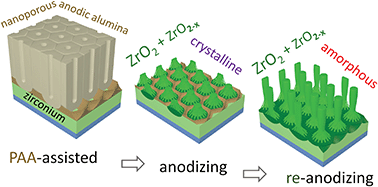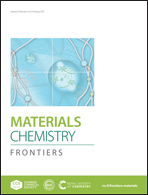Zirconium oxide nanoarrays via the self-organized anodizing of Al/Zr bilayers on substrates†
Abstract
The fabrication of ZrO2 nanostructures, such as nanowires or nanorods, arrayed on substrates and having certain and reproducible microstructures and chemical compositions presents a challenge. Here we synthesize, for the first time, 1- and 3-dimensional zirconium-oxide nanostructures highly aligned on substrates via the self-organized anodizing and subsequent re-anodizing of pure Zr (99.99%) layers, following the initial formation of a porous anodic alumina (PAA) overlayer, at voltages ranging 50 to 500 V. The films formed after the dissolution of PAA consist of upright-standing zirconium-oxide nano-protrusions shaped like ‘polyps’ (anodized samples) or pillars and rods (re-anodized samples) anchored by tiny widespread nanoroots to the bottom oxide layer. The arrays synthesized in 0.2 M H3PO4, which was chosen as a model electrolyte, consist of stoichiometric ZrO2, the suboxides Zr2O3 and ZrO, a minor amount of Al2O3, and traces of PO43− species. Unexpectedly, all the anodic zirconium oxide in the re-anodized sample forms in an amorphous and perfectly flawless manner. The oxide grows due to the cross-migration of oxygen and zirconium ions with nearly equal transport numbers, which is a unique situation for anodic films on pure Zr metal. Annealing the films at 600 °C in air increases the oxidation state of the zirconium ions and induces an amorphous-to-crystalline transition, with the formation of highly textured monoclinic ZrO2 (P21/c) nanocrystallites, without generating destructive stresses or physical defects. Annealing under vacuum (10−4 Pa) partly reduces the oxide to Zr metal, with the concurrent growth of a ZrO2 phase of the same structure and texture but in substantially larger amounts. The impact of these new findings, with detailed understanding of the abnormal ionic transport, paradoxical oxide growth, and phase-transition effects, is considered, focusing on specific applications relating to surface finishing, electronics, optics, and biomedicine.



 Please wait while we load your content...
Please wait while we load your content...